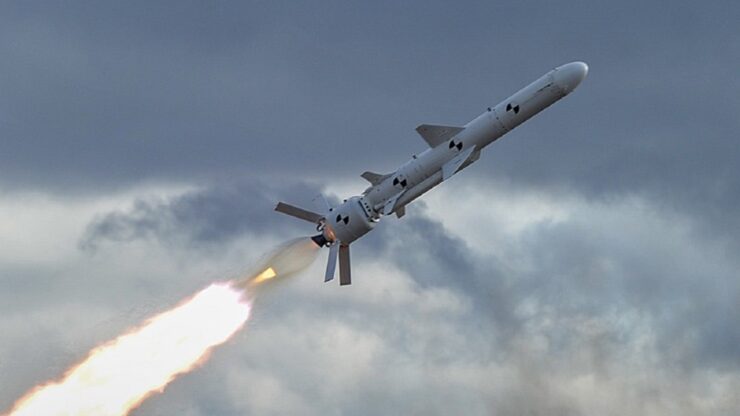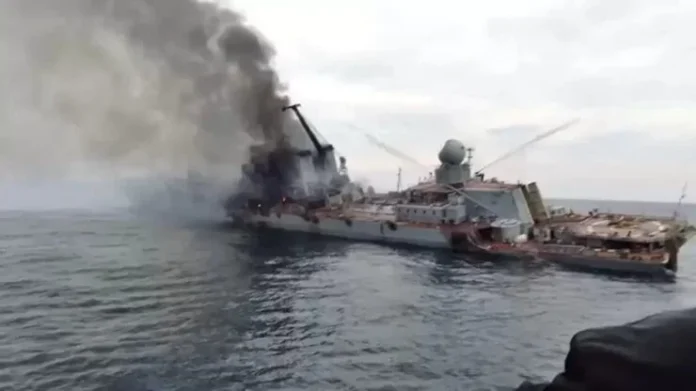On April 14, 2022 two ground-launched R-360 Neptune anti-ship cruise missiles punched big holes in the side of a warship called Moskva, the pride of Russia’s Black Sea fleet which went down to the bottom of the sea about 90 km off the Ukrainian coast.
This was a big and irreparable loss for the Russian military – both for economic and psychological reasons considering the fact that the 12,500-tonne Moskva, was the flagship of the Russian Navy and the most powerful warship in the Black Sea region.
A flagship is typically the largest, fastest, and most heavily armed vessel used by the commanding officer also known as a flag officer who is entitled to hoist a distinctive flag. It is the lead ship of a group of naval ships.
The Neptune is a Ukrainian anti-ship cruise missile based on the Soviet Kh-35 anti-ship missile and similar to the combat-proven Harpoon anti-ship missile, but with a longer range.
As the flagship of Russia’s Black Sea fleet, Moskva’s key role was to spearhead the attack and launch Kalibr cruise missile attacks on airfields and logistic centres in Ukraine. Its mission was to provide protective cover or air defense shield for the Russian forces in the Black Sea as such it was one of the most visible Russian war-fighting assets in the Russo-Ukraine war.
Moskva’s sinking reinforces what Winston Churchill wanted to convey when he said, warships are like eggshells armed with hammers- one hit is enough to put the ship out of action and cause them to sink. The damage caused by just one missile that penetrates and explodes is enough to immobilise and make a warship unusable.
The sinking of the Moskva raises a number of questions like why the vessel couldn’t detect the incoming missiles. It is not common for a frontline ship like the Moskva to be sunk by a few anti-ship missiles. Was it an intelligence failure that made the crew careless enough to believe that Ukraine did not have anti-ship missiles attack system?
All this seems quite strange, considering the fact that Moskva was equipped with a triple-tiered air defense system that can provide early warning and an adequate chance of intercepting any incoming Neptune missiles, three-to-four minutes in advance and engage it with a surface-to-air missile. The Moskva reportedly had S-300F and OSA surface-to-air missiles, chaff or decoys, electronic jamming, or the last-ditch AK-630 close-in weapon systems but there is no record that the crew activated these systems in time to ward off the impending danger. According to defence analysts, the ship’s radars either failed to detect the incoming Neptune missiles or the defences were not ready to engage the threat, implying a lack of training for such an emergency in the ship’s crew. It is also not clear how many of the 500 crew members on the ship managed to escape the vessel before it sank.
According to Al Jazeera, “Moskva was armed with multiple anti-ship and surface-to-air missiles and was the only ship of its class in the Black Sea. The two other missile cruisers –Marshal Ustinov and Varyag – are deployed with Russia’s Northern and Pacific fleets respectively.”
The sinking of Project 1164 Atlant class Moskva warship named after the Russian capital Moscow was a big morale booster for Ukraine which promptly promoted Rear Admiral Oleksiy Neizhpapa the commander of Ukrainian naval forces to the rank of Vice-Admiral as a reward for making the herculean task – possible.

Moskva which replaced the Kynda-class cruiser Admiral Golovko as the flagship of the Russian Black Sea Fleet was one of the most powerful warships to be lost in combat anywhere in the world and the largest Russian warship to be sunk since World War II. The last such incident happened when the British nuclear-powered submarine HMS Conqueror hit a torpedo that sunk General Belgrano an Argentine cruiser with a crew of about 1,100 personnel on board during the Falkland Islands war on May 2, 1982.
Moskva also happens to be the largest warship ever to be destroyed by a missile. It was also the first Russian flagship to go down to the bottom of the sea since the 1905 Russo-Japanese War fought between the Japanese and Russian Empire over imperial ambitions in Manchuria and Korea. The Russians suffered more than 90,000 casualties in the war in which Russian flagship ‘Knyaz Suvorov’ was torpedoed and sunk by Japanese torpedo boats.
Nicknamed “carrier killer”, the Moskva was typically known for its offensive punch and was designed to counter US aircraft carrier groups and provide air defence to Soviet vessels operating in distant oceans. But surprisingly none of this paraphernalia could save the three-quarters-of-a-billion-dollar ship from going down to the bottom of the sea.
The Moskva was armed with a range of anti-ship and anti-aircraft missiles as well as deck guns, torpedoes, mortars, missile defence systems as well as nuclear weapons. Equipped with 16 P-1000 Vulkan missile launchers as its main armament, it was deployed in various Russian conflicts in Georgia (2008), as well as Crimea (2014), and provided air defence for Russian forces operating in Syria (2015).
According to defence analysts, Moskva’s loss underscores the vulnerability of warfighting vessels and battleships to ground, air, or sea attacks. Hence the US Navy may want to keep its surface ships well out of range of the anti-ship missiles deployed on the Chinese mainland. Even Taiwan is understood to be keen on purchasing low-cost anti-ship missiles similar to the ones used by Ukraine to hit the Moskva.
Probably one of the lessons to be learned from all this is that warships ought to be more vigilant in coastal areas due to a greater risk of cruise missile attack from shore-based platforms close by and limited time for response. History is replete with many examples of warships that fell victim to anti-ship missile attacks because of poor readiness and situational awareness. For instance, Hanit an Israeli corvette narrowly escaped such a surprise attack in 2006 because the missile did not arm and struck a glancing blow.
That’s not all. There are a number of virtually ‘unstoppable and invincible’ land, air, and sea-borne weapons and hypersonic missiles available today that can travel at ten times faster than the speed of sound and cover a range of over a thousand miles. For many of them, ship-killing is like child’s play.
According to the Institute for the Study of War (IOW) Moskva’s loss – regardless of the cause – was a “major propaganda victory for Ukraine” and is likely to undermine Russian morale.
Meanwhile, Moskva’s loss is beginning to dilute the killer punch and intensity of the Russian invasion.
The net result of all this is that Russian forces have withdrawn from Snake Island in the Black Sea which shot to worldwide fame overnight since the early hours of the Russian invasion. The strategic importance of Snake Island is that it controls the approach to Ukraine’s other three commercial ports – including Odessa, its main port on the Black Sea port. This is being hailed as a major military victory for Ukraine – besides reopening the doors for its grain exports.
“The Russian defeat on the Snake Island will alleviate some pressure off the Ukrainian coast by removing Russian air defence and anti-shipping missile systems from the island,” the IOW said.
-The writer is a seasoned media professional with over three decades of experience in print, electronic, and web media. He is presently Editor of Taazakhabar News
–The writer is a seasoned media professional with over three decades of experience in print, electronic, and web media. He is presently Editor of Taazakhabar News. The views expressed are of the writer and do not necessarily reflect the views of Raksha Anirveda






